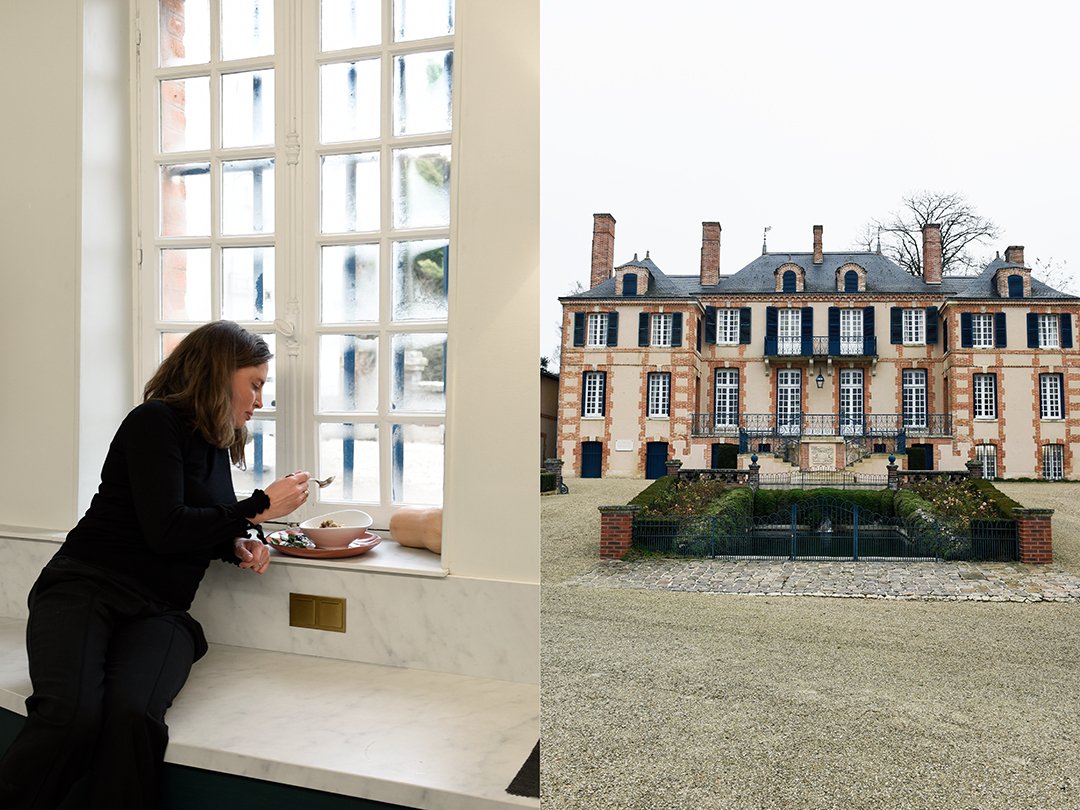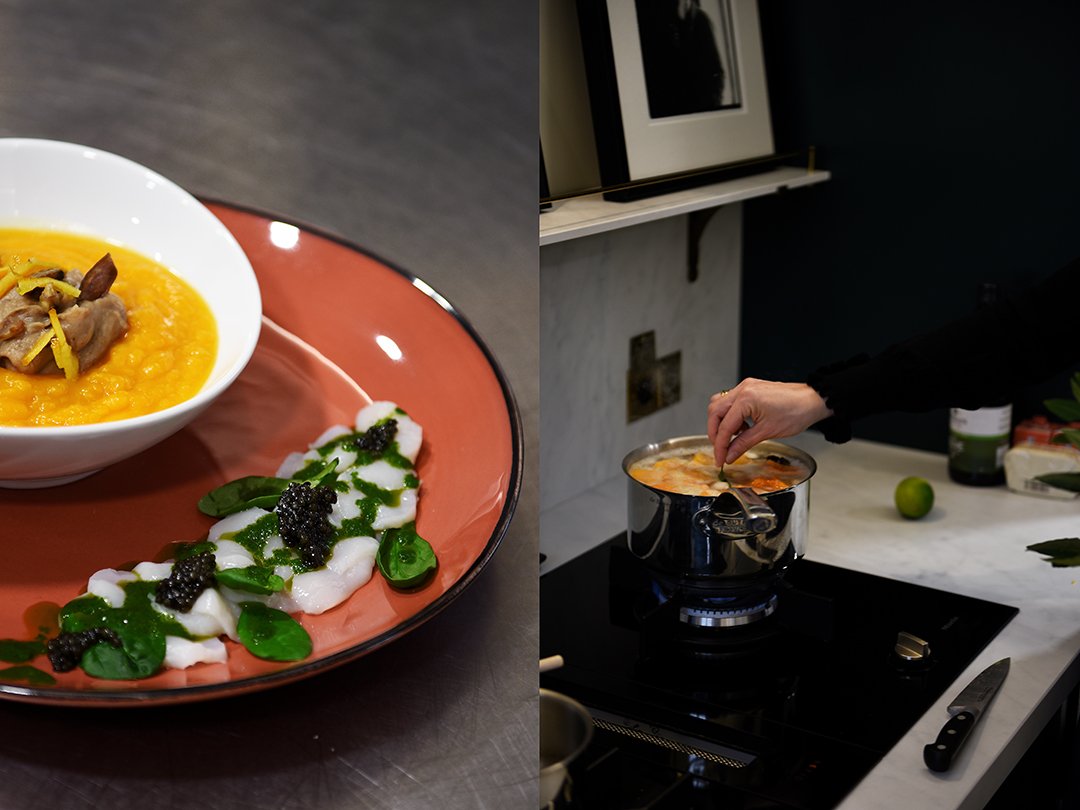Meet In Your Kitchen | Champagne, Scallops & Squash Soup with Vitalie Taittinger
This post is part of my Meet in My Kitchen podcast: How did we get to where we are in life & what does food have to do with it
"Food is love. It's the attention we can give to the people we are sharing life with." - Vitalie Taittinger
48 hours in the Champagne with Vitalie Taittinger - many bottles were popped and no dessert was missed in the making of this podcast episode!
Vitalie was born in Reims, she's the great-granddaughter of Champagne Taittinger's founder Pierre Taittinger and now she is the President of the champagne house. Two years ago, she took over from her father, Pierre-Emmanuel. When I first met the young woman a few years ago, I asked myself if it's a gift or a burden to be born into one of the world's most famous champagne families, if it's freedom or pressure.
"The fact that today we are both responsible for the company, I think this is something very strong in terms of complicité." - Vitalie Taittinger
Clovis is Vitalie's brother, he's the company's Managing Director. When it came to the decision who of the two children would follow into their father's footsteps, the father specifically didn't want to be part of the final decision making process. Instead, for a whole year, the entire team, including the two siblings, pondered on what would be best for the company. For them it was neither about ego nor about clever career moves. It was simply about finding a solution that would be best for Champagne Taittinger; that would be best to keep a tradition alive and thriving. This story says so much about a family and about a region and its mystified product. It says so much about what champagne is about.
The Champagne region is a tiny cosmos built on history, values, tradition, and trust. It goes beyond family although the families that founded the big houses and cultivated champagne over hundreds of years are at the core of this cosmos. It's important to understand that all the champagne houses on their own can't cover the demand of grapes for their production just by using the produce from their own vineyards. It's just not enough. They depend on a large network of small independent growers in the region. There are contracts yet if the growers don't want to cooperate with a champagne house, the champagne house won't survive. They both depend on each other, which is fruitful and only works when their cooperation is built on trust, respect, and the same values. Land is precious and limited - and a UNESCO world heritage since 2015. It's one of the most expensive in the wine world. € 1 million per acre, only topped by Bordeaux's and Burgundy's top appellations.
"A company is a human adventure and when you’re a family you stay very close to these human values." - Vitalie Taittinger
When Taittinger was sold by the extended family in 2005 - a step Vitalie's father didn't agree with - it only took him a year to have the support from a local bank and the backup from the growers to buy the company back and be assured that he would manage to keep producing outstanding champagne.
So when Vitalie joined the company in 2007 quite spontaneously, after studying art and establishing a life independent of Taittinger, she was aware of the responsibility given into her hands but also about the chance she got to keep the story of her family's champagne alive so that one day she could pass it on to the next generation: "The fact that we are a family running the company puts the adventure into a longterm process. I think we are not fighting for figures we fight to make this adventure last and transmit it to the next generation. We want to transmit the best terroir to the next generation and we want to pay attention to the health of the next generation."
"Déjeuner en l'Honneur de Madame Meike Peters" - Merci beaucoup, Vitalie!
The past is deeply woven into the region, it's constantly present, contributing to the mystique of the Champagne: no matter if your in Reims visiting Notre-Dame de Reims, the cathedral chosen for the coronation of the kings of France; if your in Taittinger's cellars 18 meters underground in the Abbey of Saint-Nicaise built in the 13th century in Roman chalk pits dating from the 4th century; or driving to the family's Château de la Marquetterie, an 18th century residence 40 minutes outside Reims, which Vitalie's great-grandfather Pierre bought in 1930. He had fallen in love with this place, a headquarter during World War I, when he spent time there as a cavalry officer in 1915.
It's not a surprise that Pierre was smitten. When I drove passed the vines and through the chateau's gate to visit Vitalie in her kitchen, and record our podcast episode in one of the salons, I was smitten, too, with Vitalie and the chateau.
Vitalie shared a recipe with me that's both cozy and sumptuous, Squash Soup with Chestnut Purée and Scallop Carpaccio with Spinach Pesto and Caviar - easy to prepare in advance and perfect for a New Year's Eve dinner!
Bonne année!
The podcast episode with Vitalie Taittinger is in English. You can listen to the Meet in My Kitchen podcast on all common podcast platforms; there are English and German episodes. You can find all the blog posts about these podcast episodes including my guests’ recipes here on the blog under Meet in Your Kitchen.
Listen to the podcast episode with Vitalie on:
Spotify / Apple / Deezer / Google / Amazon / Podimo
On Instagram you can follow the podcast @meetinmykitchenpodcast!
Squash Soup with Chestnuts, Scallop Carpaccio and Caviar
by Vitalie Taittinger
The scallops are eaten raw and need to be very fresh. If this seems too risky for you, sear the scallops quickly in a little olive oil over high heat on both sides (this takes 2-3 minutes) and season with salt and pepper.
Serves 4
For the scallop carpaccio
10 very fresh scallops
Caviar, adjust the amount to your budget
For the spinach pesto
1 large handful fresh baby spinach leaves, plus 16 small spinach leaves for serving
Olive oil
1 lime
Fine sea salt
Ground black pepper
For the soup
1 liter / 4 1/4 cups vegetable broth
1 butternut squash (about 3 pounds), peeled, seeds removed, and cut into cubes
1 star anise
2 bay leaves
Fine sea salt
Ground black pepper
Crème fraîche, to taste
For the chestnut purée and topping
200g / 7 ounces vacuum-packed whole cooked chestnuts
120ml / 1/2 cup heavy cream, whipped until stiff
2 teaspoons granulated sugar
1 tablespoon freshly grated, or very finely chopped, orange zest
For the scallop carpaccio, keep the scallops in the freezer for a couple hour; this will make it easier to cut them.
For the soup, bring the broth to a boil then add the squash, star anise, and bay leaves, season to taste with salt and pepper, reduce the heat, and simmer for about 30 minutes or until the squash is soft. Remove and discard the star anise and bay leaves. Using a blender stick or blender, purée the soup until smooth then season to taste with salt, pepper, and crème fraîche and cook, stirring constantly, until it reaches the desired taste and texture; cover the pot and keep warm.
For the chestnut purée, set 3 chestnuts aside then purée the remaining chestnuts until smooth (add a little water if necessary) and, using a spoon, gently mix with the whipped cream.
Crumble the 3 reserved chestnuts. In a small, heavy pan, heat the sugar over medium-high heat until caramelized then add the crumbled chestnuts and orange zest; stir and keep warm for serving.
For the spinach pesto, purée the spinach leaves and a little olive oil in a blender until smooth. Add more olive oil until the texture is quite runny then season to taste with freshly squeezed lime juice, salt, and pepper.
Take the scallops out of the freezer. Using a large, sharp knife, cut the scallops very thinly; if they are too hard to cut keep them at room temperature for a few minutes.
Arrange the scallop slices on 4 large plates, drizzle with a little spinach pesto (you might not need all of the pesto), sprinkle with a few spinach leaves and a little caviar. Fill the soup in 4 deep bowls and arrange the bowls on the large plates with the carpaccio. Arrange the caramelized chestnuts and a dollop of the puréed chestnuts on top of the soup and serve immediately.

















